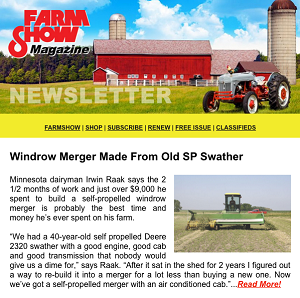Autonomous Cotton Picker In Development
 ✖  |
Autonomous cotton pickers may soon be a reality, thanks to work by Mississippi State University (MSU) researchers. An artificial intelligence (AI) system with stereo vision identifies bolls ready to be picked and their exact 3D position. Robotic fingers are activated to secure them.
“Cotton bolls mature over a period of 50 days,” explains J. Alex Thomasson, MSU agricultural and biological engineering department head. “With current technology, the earliest maturing bolls have degraded by the time picking finishes.” Thomasson, part of the research team sponsored by Cotton Inc., envisions a swarm of small harvesters. Equipped with the autonomous technology, they could make multiple trips through the field over the 50-day period, picking bolls as they matured.
“The harvesters could maximize the quality of the cotton harvested,” says Thomasson. “Multiple harvests could minimize potential losses from hurricanes striking before a single harvest.”
While AI systems with cameras are being applied in many sectors, it’s the fingers called “end effectors” that set the cotton-picking robot apart. Hussein Gharakhani, designer of the end effectors, was inspired by a lizard’s tongue reaching for its prey.
“The end effectors use three sets of rotating belts with pins that grasp the cotton boll,” explains Thomasson.
The grippers are being placed on a robotic arm by Xin Zhang, another research team member. She’s using a commercial six-degrees-of-freedom robotic arm and a 3-wheel drive robotic platform. Called the Husky, it’s made by Clearpath Robotics and operates with a GPS navigation unit and a perception module.
The AI perception module, with its AI-based processor is equipped with an RGB depth-based camera and a 3D lidar sensor for obstacle avoidance. Zhang is simulating the modules’ performance in a virtual cotton field, as well as testing the robot in the field at a university research site.
“For the last few years, we’ve been building and testing these systems individually, and over the next year, we’ll focus on integration and navigation with the goal of building a completely autonomous harvester that can work across unpredictable and uneven terrain,” she said.
Thomasson expects research fields to host the initial application of autonomous harvesters. Plant breeders can work with 1,000 different genotypes in research plots.
“The autonomous cotton picker could harvest plots, pick the mature bolls, and record where they were picked,” he says.
Pulling samples from cotton bales for quality analysis is another potential use for the end effector fingers.
Thomasson acknowledges that the technologies being developed are still far from commercialization. However, the growing farm labor shortage, combined with the impact of soil compaction caused by modern 30-ton harvesters, is driving interest in autonomous equipment.
Contact: FARM SHOW Followup, Alex Thomasson, 150 Agricultural and Biological Engineering, Mississippi State, Miss. 39762 (ph 662-325-3282; athomasson@abe.msstate.edu)
Autonomous Cotton Picker In Development Autonomous cotton pickers may soon be a reality thanks to work by Mississippi State University MSU researchers An artificial intelligence AI system with stereo vision identifies bolls ready to be picked and their exact 3D position Robotic fingers are activated to secure them “Cotton bolls mature over a period of 50 days ” explains J Alex Thomasson MSU agricultural and biological engineering department head “With current technology the earliest maturing bolls have degraded by the time picking finishes ” Thomasson part of the research team sponsored by Cotton Inc envisions a swarm of small harvesters Equipped with the autonomous technology they could make multiple trips through the field over the 50-day period picking bolls as they matured “The harvesters could maximize the quality of the cotton harvested ” says Thomasson “Multiple harvests could minimize potential losses from hurricanes striking before a single harvest ” While AI systems with cameras are being applied in many sectors it’s the fingers called “end effectors” that set the cotton-picking robot apart Hussein Gharakhani designer of the end effectors was inspired by a lizard’s tongue reaching for its prey “The end effectors use three sets of rotating belts with pins that grasp the cotton boll ” explains Thomasson The grippers are being placed on a robotic arm by Xin Zhang another research team member She’s using a commercial six-degrees-of-freedom robotic arm and a 3-wheel drive robotic platform Called the Husky it’s made by Clearpath Robotics and operates with a GPS navigation unit and a perception module The AI perception module with its AI-based processor is equipped with an RGB depth-based camera and a 3D lidar sensor for obstacle avoidance Zhang is simulating the modules’ performance in a virtual cotton field as well as testing the robot in the field at a university research site “For the last few years we’ve been building and testing these systems individually and over the next year we’ll focus on integration and navigation with the goal of building a completely autonomous harvester that can work across unpredictable and uneven terrain ” she said Thomasson expects research fields to host the initial application of autonomous harvesters Plant breeders can work with 1 000 different genotypes in research plots “The autonomous cotton picker could harvest plots pick the mature bolls and record where they were picked ” he says Pulling samples from cotton bales for quality analysis is another potential use for the end effector fingers Thomasson acknowledges that the technologies being developed are still far from commercialization However the growing farm labor shortage combined with the impact of soil compaction caused by modern 30-ton harvesters is driving interest in autonomous equipment Contact: FARM SHOW Followup Alex Thomasson 150 Agricultural and Biological Engineering Mississippi State Miss 39762 ph 662-325-3282; athomasson@abe msstate edu





